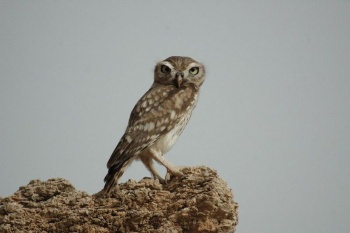- Athene noctua
Identification
21–23 cm (8¼-9 in)
- Back and wings are a deep grey-brown, spotted with white
- Underparts white with broad, broken streaks of grey-brown
- Brown cheeks
- Yellow eyes
- Whitish supercilia
- White throat
Distribution
The commonest of the smaller owls and widespread in Europe from Iberia east to the Urals and Caspian, in the north reaching Denmark and the southern shores of the Baltic. Introduced to Britain and now established north to southern Scotland. Occurs virtually all around the Mediterranean and on most islands, throughout the Caucasus and Turkey, south to Iraq and parts of the Middle East. Also found throughout North-West Africa and much of central and southern Algeria, coastal Libya and at scattered oases in the interior, the Tibesti region of Chad and in the Nile Valley. Has bred in southern Sweden and possibly on the Balearics.
Resident throughout range with short-distance dispersal of juveniles.
Vagrants recorded in Ireland, Fenno-Scandia, Estonia and on Malta and the Canary Islands.
Taxonomy
Lilith Owlet (Athene lilith) has been separated as a full species by some authorities[5] based on both vocalizations and DNA studies.
Subspecies
Several races occur in the region differing slightly in size, ground colour and markings but there is much intergradation.
- Nominate noctua is found over much of southern Europe from Corsica and Sardinia east to the Carpathians.
- Race indigena from South-East Europe, southern Russia, Turkey to the Caucasus and in the Middle East is paler and more russet above.
- The west European vidalii is the darkest race, colder brown above, and occurs from Iberia to Poland and the Baltic States and also introduced to Britain.
- Paler races occur further south with glaux from North Africa to southern Israel rather rufous above and variable
- saharae from more inland areas of North Africa which can be rufous, sandy or greyish and
- bactriana from the south-east of Region in Azerbaijan resembles indigena but paler.
- Arabian race lilith is the palest, very pale buff above and barely streaked below.
Additional subspecies included in Clements[1]:
- A. n. spilogastra:
- A. n. somaliensis:
- A. n. orientalis:
- A. n. impasta:
- West-central China (Kokonor and western Gansu)
- A. n. ludlowi:
- A. n. plumipes:
Habitat
Farmland with hedgerows, copses and scattered trees, also rocky hillsides and semi-deserts. Particularly fond of old orchards and pollarded trees affording nest holes.
Behaviour
Little owls have often sit sunning themselves in early mornings or late evenings, particularly during cold weather. This is often the best chance of seeing them.
Diet
Diet includes small mammals, such as mice, voles, shrews, even small rabbits, as well as insects, earthworms, snails, slugs and small fish.
Breeding
The nest is in a hole (tree, walls, old buildings, rabbit burrows or cliffs). Incubation of the 3-5 eggs starts in early May and takes 29 days. Initially the male is solely responsible for feeding the chicks, later joined by the female. The chicks fledge after 26 days
Vocalisation
References
- Clements, J. F., T. S. Schulenberg, M. J. Iliff, D. Roberson, T. A. Fredericks, B. L. Sullivan, and C. L. Wood. 2018. The eBird/Clements checklist of birds of the world: v2018. Downloaded from http://www.birds.cornell.edu/clementschecklist/download/
- Wikipedia
- BBC Science & Nature
- Collins Field Guide 5th Edition
- König, C. and F. Weick 2008. Owls of the World, second edition. Christopher Helm, London. ISBN 978-0-7136-6548-2
Recommended Citation
- BirdForum Opus contributors. (2025) Little Owl. In: BirdForum, the forum for wild birds and birding. Retrieved 1 May 2025 from https://www.birdforum.net/opus/Little_Owl
External Links
Search the Gallery using the scientific name:
Search the Gallery using the common name:
GSearch checked for 2020 platform.







